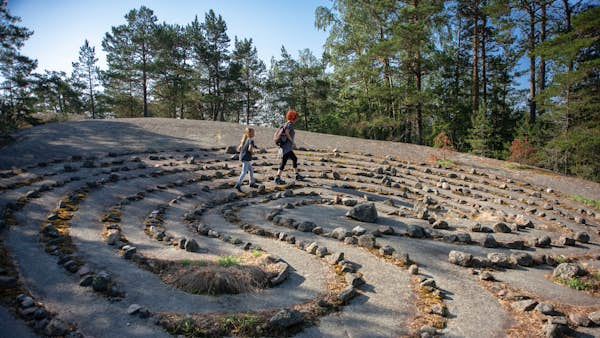
Hiked the Camino? Here are 7 pilgrimages to consider for your next challenge
A sacred path to spiritual renewal. A journey from head to heart. A test of endurance. A life-changing road to enlightenment.
Since time immemorial, people have gone on pilgrimages to seek forgiveness, give thanks, pray or find inner peace and purpose in times of change and crisis. St Augustine nailed it 1500 years ago when he said: “solvitur ambulando” (“it is solved by walking”). After all, what could be more intuitive than putting one foot in front of another, following a clear path to a goal? A pilgrimage is a metaphor for life.
And across the world, pilgrimages are booming.
In 2023, a record-breaking 446,073 pilgrims walked the Camino de Santiago to the shrine of the Apostle St James. But this well-trodden path is merely the first among equals among the world’s great pilgrimage routes.
Religious or not, you will be profoundly touched by the natural beauty, history and unique insights into culture and spirituality on these seven epic pilgrimages – slow-travel adventures taking you from the mist-draped mountains of Japan to the island-speckled south coast of Finland.
1. St Olav Waterway, Sweden and Finland
Best for island hopping and sea views
To slip away from civilization and back to nature, the island-hopping, coast-hugging St Olav Waterway that links Turku in Finland with Eckerö (Åland) in Sweden is the dream. A rousing 10-day romp of 215km (134 miles), this is a pilgrimage trail like few others. For starters, you don’t have to walk it – you can cycle or kayak if you prefer, with ferries joining the gaps.
Whatever your mode of transport, look forward to stupendous views of sea and sky. The trail skips over many rocky isles and skerries as it crosses the Åland Islands, where you have the space to zone out for a spell and be at one with the blues of the Baltic and greens of the pine forest in a place silent enough to hear your own heartbeat. Bring binoculars and you might well spot migratory birds, hares, deer and the odd elk swimming from island to island.
Following the route pilgrims hiked and sailed in the Middle Ages and honoring one of the most famous Scandi saints, this route is less about showstopping highlights and more about embracing every element and sense along the way. Admire the brilliant stars as you wild camp. Take bracingly cold post-sauna dips in the sea. Stop off in tiny, timber-built villages and savor local produce for picnics at wayside farm shops.
After a week or so, you’ll discover lost rhythms and find a deeper connection with the Nordics and their wondrous nature.

2. Kumano Kodō, Japan
Best for holy shrines and hot springs
Threading into densely wooded mountains on Japan’s Kii Peninsula, the Kumano Kodō is a UNESCO-listed network of pilgrimage trails leading to the Kumano Sanzan, or Three Grand Shrines of Kumano. Once a sacred pilgrimage trail for enlightenment-seeking emperors and samurai, these paths have been trodden for more than a millennium.
Today, the landscape they cut through continues to pulse with a special energy. Walkers can expect ethereally lit bamboo groves, fern-flecked forests and terraced rice paddies, waterfalls plunging over cliff faces and holy mountains revered as kami (gods), Buddhist temples and Shintō shrines.
The main path to Kumano is the Nakahechi Route (Imperial Route) – a well-mapped, 68km (42-mile) journey on foot to unite mind, body and spirit through the challenge of the trail and the beauty of nature. It’s a solid four days of walking up into ragged mountains, through mist-veiled forests and along old stone paths polished smooth by pilgrims’ weary-yet-determined feet. Tea houses and simple inns provide rest and refreshment in isolated villages; you’ll want to follow centuries-old ablutions rituals by bathing in the World Heritage hot springs of Yunomine Onsen. At the end, you’ll descend to the ancient shrine of Hongu Taisha, which has the world’s biggest torii gate.
Summers on the Kii can be hot and humid and winters cold, so come in the shoulder seasons for mild days and few crowds – plus spring cherry blossoms or glorious autumn foliage.

3. Via Francigena, Italy
Best for heights and hill towns
In the saintly hall of fame, few shine brighter than St Francis of Assisi, born in his namesake town in Umbria in 1181. Founder of the Franciscan order, this most venerated of Italian saints lived a life of utmost poverty and penance – we’re talking rolling around in thorn bushes to resist temptation, wearing a ragged habit (he only owned one), eating barely nothing and sleeping on stone. St Francis loved nature, saved animals and worked many a medieval miracle, from walking on water to healing the sick and raising the dead. As saints go, few can touch him.
Celebrating its 30th anniversary in 2024, the Via Francigena follows in his devout footsteps. If you thought the Camino was challenging, try this 1200km (745-mile) pilgrimage from Canterbury’s Gothic, UNESCO-listed cathedral (where Thomas Becket was killed in 1170) to Santa Maria di Leuca in Puglia at Italy’s sun-scorched heel. As you tramp from England to France, Switzerland and Italy, the weather gradually warms and skies get bluer. The landscapes that unfold are cinematically beautiful: vineyards, fast-flowing rivers and forests, olive-cloaked hills and snow-frosted Alps. In between, abbeys, castles, medieval towns and all the wonders of Rome await. On the lonely stretches, a sense of spirituality endures.

4. The Portuguese Way, Portugal
Best for an alternative route to Santiago
If the idea of Santiago appeals – yet throngs of pilgrims on the busy Camino Francés (French Way) don’t, there are other ways you can set out and earn your official Compostela certificate. While 219,785 blister-footed pilgrims trekked across the Pyrenees through France and Northern Spain to Santiago’s resplendent medieval cathedral in 2023, just 88,717 came via Portugal. Cue the popular-but-still-less-crowded Caminho Português (Portuguese Way), a spiritually uplifting, month-long, 620km (385-mile) stomp from the Portuguese capital of Lisbon to Santiago de Compostela.
Wild Atlantic coastlines, forested hills and national parks stitch together time-lost villages and some of Portugal’s most outstanding cultural sites – from alley-packed, moodily atmospheric Coimbra, medieval capital for more than a century and home to the UNESCO-listed university that’s the country’s oldest; to convent-topped Tomar, a Knights Templar stronghold; and Moorish Santarém. Stop at beaches for boat-fresh shellfish and vibrant sunsets.
The trail is well-signposted and moderately challenging (expect inclines but no real climbs); the weather tends to be agreeable, too, with spring and autumn the ideal times to walk. Tip: if you want to shave off a bit of time, just hike the 265km (165 miles) from Porto. From here, it takes “only” 10 to 12 days to reach Santiago.
5. St Paul Trail, Türkiye
Best for history and slow travel
The apostle St Paul hailed from Tarsus and spread the Christian faith in Asia Minor in the first century. Honoring this foundational early saint and tracing his footsteps as he embarked on his first missionary journey to Anatolia, the St Paul Trail presents a deep dive into a rural side of Türkiye that few visitors get to see. You’ll need to be fit for the 500km (310-mile), at-times-tough hike from the ancient city of Perge (just north of Antalya on the Mediterranean coast) to Yalvaç near Lake Eğirdir. The path is well marked, with handy white-and-red stripes on rocks and trees.
History lovers will be in their element here, as the route picks its way along stone-paved Roman roads, medieval paths and old shepherd trails, taking in aqueducts and ancient theaters; Roman, Byzantine and Ottoman towns and cities; and ruined temples, castles, mosques and churches. But the wild beauty of the Taurus Mountains also touches deep: pine, beech and juniper forests, high pastures, canyons and valleys, glass-clear streams and turquoise falls. In between are hamlets where the pace of life is refreshingly slow, where cheese and yogurt are still made the traditional way, and in which you can momentarily forget which century we live in.
Avoid the blistering heat of summer and opt instead for spring or autumn. April, May, September and October are fine times to hike this month-long trail, along which you’ll be staying in private homes, at simple B&Bs or under canvas.

6. Adam’s Peak, Sri Lanka
Best sacred mountain sunrise
Soaring high above the lush green tea plantations and forests of Sri Lanka’s cloud-wreathed Central Highlands, cone-shaped, 2243m(7360ft)-high Adam’s Peak (Śrī Pāda) is the country’s most sacred mountain. Scrambling up 5200 steps to the top is a rite of passage for pilgrims of different faiths, who flock here from the world over to pray and express gratitude.
The name refers to the giant footprint-shaped marking at the summit, which some say is where Adam first set foot on earth when he was cast out of the Garden of Eden. Buddhists believe it was left by Buddha en route to paradise, while Hindus insist it is Shiva’s doing. No matter the religion, this holiest of peaks is the end goal of a long, sweaty, back-breaking climb from the village of Dalhousie (allow around 8 hours for the up-and-back trek).
Religious or not, climbing Adam’s Peak is a spiritual experience – and proof that you don’t need to hike for days or weeks to experience the transformative power of pilgrimage. Begin at night as the stars twinkle, joining fellow pilgrims with head-torches flickering like fireflies to climb the steps. You’ll then arrive at the summit as day breaks and sunrise touches the island like a golden blessing. The pilgrimage season begins on poya (full moon) day in December and runs until the Vesak festival in May.

7. Wexford Pembrokeshire Pilgrim Way, Ireland and Wales
Best for wild waves and Celtic spirit
Just imagine for a second how St Aidan must have felt back in the sixth century as he trod, staff in hand, along the wave-whipped shores of the Atlantic from Ferns in Ireland to St Davids in Wales to meet his mentor St David.
Now drop yourself right in the moment.
The recently launched Wexford-Pembrokeshire Pilgrim Way is a tale of two saints and two Celtic lands. Heading up and over gorse-clad cliff and along dune-flanked beach for 260km (162 miles) and crossing the Irish Sea by ferry, this pilgrimage trail enthralls with cultural heritage in the form of ruined abbeys, romantic castles, Celtic wells, Marian shrines and the clincher: magnificent St David’s Cathedral, which hosts the relics of Wales’ beloved patron saint.
Believer or not, nature is sure to grab you. In what the Celts would have described as a “liminal space” – where the gap between heaven and earth is small – these coastal landscapes touch the soul. Feel the spiritual connection with the living world standing atop wild, storm-smashed, lighthouse-topped Strumble Head, where seabirds (fulmars, razorbills, guillemots, peregrines) dive and screech while dolphins and seals splash offshore.
Broken up into nine bite-sized day walks of roughly 14 miles (22km) apiece and digitally way-marked, the trail is easy enough to hike and navigate, with overnight accommodation offered at sanctuaries, farms and hostels.
You May Also Like

4 Luxurious Face Oils for Gua Sha
December 21, 2023
6 Facts You Didn’t Know About Yolanda Hadid
February 17, 2024

